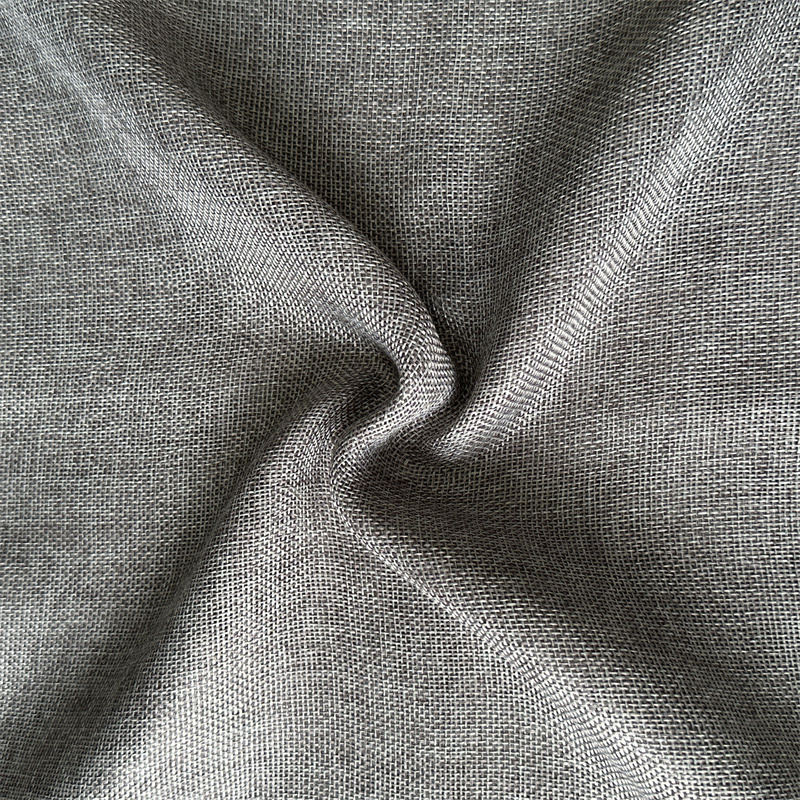In today's diverse textile market, polyester linen blended fabric (Polyester Linen Fabric) has gradually become a popular choice for consumers and designers due to its unique properties and wide application. This fabric perfectly combines the durability of polyester with the natural texture of linen, retaining the advantages of natural fibers while making up for the shortcomings of a single material.
The addition of polyester significantly improves the strength and wear resistance of the fabric, making it more durable and suitable for making items that need to be used frequently, such as clothing, household items, etc.
Improved comfort
The natural properties of linen fiber give blended fabrics good breathability and moisture absorption, which can effectively regulate body temperature and provide a comfortable wearing experience. This makes polyester linen blended fabrics particularly suitable for summer clothing.
Anti-wrinkle performance
Pure linen fabrics are prone to wrinkling, and the addition of polyester greatly improves this problem. The blended fabric is easier to care for, reducing the need for ironing and improving the convenience of daily use.
Environmental protection potential
With the popularization of the concept of sustainable development, many manufacturers have begun to use recycled polyester and organic flax to produce blended fabrics to reduce the impact on the environment.
Rich appearance effect
Polyester linen blended fabric combines the natural texture of linen and the gloss of polyester, presenting a unique visual effect. At the same time, it can also achieve a variety of colors and pattern designs through dyeing and printing processes to meet the needs of different styles.
Production process of polyester linen blended fabric
The production process of polyester linen blended fabric mainly includes the following steps:
Raw material preparation
Polyester fiber and linen fiber are mixed in a specific ratio. The common blending ratio is 65% polyester and 35% linen, but the ratio can also be adjusted according to demand.
Spinning
The mixed fibers are made into yarn through the spinning process. Due to the different physical properties of polyester and linen, special attention should be paid to the uniform distribution and tension control of the fibers during the spinning process.
Weaving
The yarn is woven into cloth using advanced looms. Different weaving methods (such as plain, twill or jacquard) affect the appearance and feel of the fabric.

Finishing
After weaving, the fabric usually goes through finishing processes such as bleaching, dyeing, and softening to further enhance its performance and appearance.
Application areas of polyester linen blended fabrics
Apparel industry
Polyester linen blended fabrics are widely used in the production of shirts, dresses, suit jackets and other clothing. Its wrinkle resistance and comfort make it an ideal choice for business casual wear, and it is also suitable for making light summer clothing.
Home decoration
In the home field, this fabric is often used to make curtains, sofa covers, tablecloths, etc. The natural texture of linen adds a warm atmosphere to the interior space, while the durability of polyester ensures the service life of the product.
Industrial textiles
Polyester linen blended fabrics are also used to manufacture products for industrial purposes, such as filter materials, protective clothing and outdoor equipment. Its strength and weather resistance enable it to adapt to various harsh environments.
Fashion accessories
Fashion accessories including handbags, hats, scarves, etc. are also often made of polyester linen blended fabrics. Its unique texture and diverse color options provide designers with rich creative space.
Future development trend of polyester and linen blended fabrics
As consumers' demands for functionality, environmental protection and personalization continue to increase, polyester and linen blended fabrics are developing in the following directions:
Intelligent functions
By adding intelligent fibers or coatings to blended fabrics, they are given antibacterial, UV protection, temperature control and other functions to meet the needs of the high-tech era.
Green manufacturing
More and more companies are beginning to pay attention to sustainable development, using recycled polyester and organic linen as raw materials, and optimizing production processes to reduce resource consumption and pollution emissions.
With the help of digital technology and intelligent manufacturing, future polyester and linen blended fabrics can be personalized according to customer needs, including customization of color, texture and function.
Polyester and linen blended fabrics are redefining the possibilities of modern textiles with their excellent performance and diverse application scenarios. Whether pursuing comfort, durability or environmental protection, this innovative material can meet the diverse needs of consumers. In the future, with the advancement of technology and the renewal of design concepts, polyester and linen blended fabrics will surely show their unique charm in more fields and bring more convenience and beauty to human life.


 中文简体
中文简体 Español
Español











